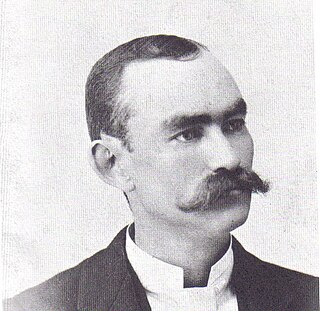Related Research Articles

Clifton is a city in Washington and Clay counties in the U.S. state of Kansas. As of the 2010 census, the city population was 554.
Camp Collins was a 19th-century outpost of the United States Army in the Colorado Territory. The fort was commissioned in the summer of 1862 to protect the Overland Trail from attacks by Native Americans in a conflict that later became known as the Colorado War. Located along the Cache la Poudre River in Larimer County, it was relocated from its initial location near Laporte after a devastating flood. Its second location downstream on the Poudre was used until 1866 and became the nucleus around which the City of Fort Collins was founded.

The 3rd Regiment Wisconsin Volunteer Cavalry was a cavalry regiment that served in the Union Army during the American Civil War.
The Concordia Blade-Empire is a local newspaper for Concordia, Kansas. It is the official newspaper for Cloud County, Kansas. The paper publishes five days a week, Monday through Friday.

Quindaro Townsite is an archaeological district in the vicinity of North 27th Street and the Missouri Pacific Railroad tracks in Kansas City, Kansas. It was placed on the National Register of Historic Places on May 22, 2002.

James Manney Hagaman was a lawyer, land agent, newspaper editor, and the founder of Concordia, Kansas. He and his wife settled in what is now Cloud County in 1860. In addition to founding the town of Concordia, he is credited with leading the movement to separate what was then Shirley Township from Washington County in 1866.
The 1st Regiment Kansas Volunteer Infantry (Colored) was an infantry regiment that served in the Union Army during the American Civil War. It was the first black regiment to be organized in a northern state and the first black unit to see combat during the Civil War. At the Battle of Poison Spring, the regiment lost nearly half its number, and suffered the highest losses of any Kansas regiment during the war.
The 1st Kansas Volunteer Infantry Regiment was an infantry regiment that served in the Union Army during the American Civil War. On August 10, 1861, at the Battle of Wilson's Creek, Missouri, the regiment suffered 106 soldiers killed in action or mortally wounded, one of the highest numbers of fatalities suffered by any Union infantry regiment in a single engagement during the American Civil War.
The 8th Kansas Volunteer Infantry Regiment was an infantry regiment that served in the Union Army during the American Civil War.
The 10th Kansas Infantry Regiment served in the Union Army between April 3, 1862, and September 20, 1865, during the American Civil War.
The 12th Kansas Volunteer Infantry Regiment was an infantry regiment that served in the Union Army during the American Civil War.
The 2nd Kansas Volunteer Cavalry Regiment was a cavalry regiment that served in the Union Army during the American Civil War.
The 5th Kansas Volunteer Cavalry Regiment was a cavalry regiment that served in the Union Army during the American Civil War.

The 6th Kansas Volunteer Cavalry Regiment was a cavalry regiment that served in the Union Army during the American Civil War.
The 7th Kansas Volunteer Cavalry Regiment was a cavalry regiment that served in the Union Army during the American Civil War.
The 9th Kansas Volunteer Cavalry Regiment was a cavalry regiment that served in the Union Army during the American Civil War.
2nd Independent Battery Kansas Light Artillery was an artillery battery that served in the Union Army during the American Civil War.
Fort Brooks, in northwest Clay County, Kansas, was located three miles west of Clifton, Kansas. Built on the north bank of the Republican River in August or September 1864, it was named for George D. Brooks. Brooks, an ensign in the Shirley County Militia, owned the farm on which the fort was located. Capt. Isaac M. Schooley, the militia commander, was also the fort's commander.
2nd Indiana Battery Light Artillery was an artillery battery that served in the Union Army during the American Civil War.
References
- ↑ "Lost Towns and Settlements". The Times. Clay Center, Kansas. January 12, 1922. p. 2. Retrieved June 5, 2018– via Newspapers.com.
- ↑ William C. Pollard, Jr., Forts and Posts in Kansas During the Civil War: 1861-1865 (Charleston: CreateSpace, June 2015), pp. 53-4.
- ↑ Frazer, p. 52; "Lost Towns," p. 2; "Fort What?,", p. 12; J. M. Hagaman, "Blade Editor Tells County History: History of Cloud County from the Earliest Settlement," The Blade Weekly (Concordia), July 29, 1980, p. 7; Hollibaugh, p. 69; Adolph Roenigk, ed., Pioneer History of Kansas (Lincoln, Kans.: Adolph Roenigk, 1933), p. 340; Carson, September 9, 1992, letter, p. 3.
- ↑ Hagaman, p. 7; "Fort What?," p. 12; Roenigk, pp. 339-40.
| This American Old West-related article is a stub. You can help Wikipedia by expanding it. |
| This article about a building or structure in Kansas is a stub. You can help Wikipedia by expanding it. |